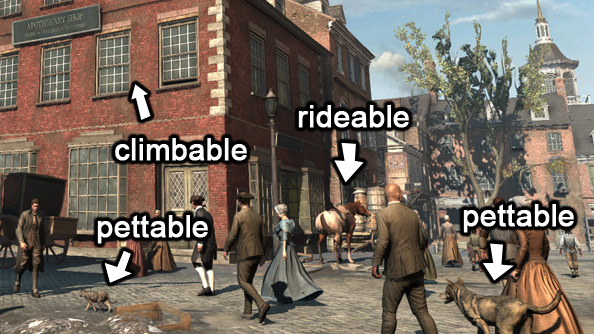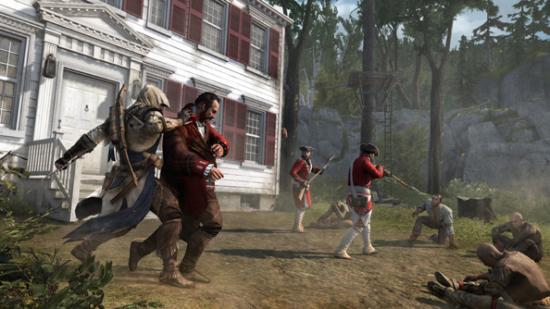You can pet dogs in Assassin’s Creed 3. It doesn’t boost your stealth rating, or increase your reputation with the local kennel club, or unlock a series of pooch-commissioned assassination contracts. It doesn’t do anything, in fact. It’s just nice, a pleasant and world-enriching distraction from all the grit and violence and knives and horribleness. You can also pet cats and pigs. Lovely lovely lovely.
I think I pet betweenten and fifteen dogs in 18th century Boston before I continued on protagonist Connor’s revolutionary adventure, which, at about four to six hours in, was introducing historical figures at a breakneck rate of two per mission. Sam Adams, who you might recognise from “beer”, and an angry historical Frenchman were conspiring to mess about with a shipment of tea belonging to a prominent Brit. Said Brit was also plotting to evict some of Connor’s native American cousins, aligning the interests of the protagonist with those of some key mission givers, and so the story campaign naturally unfolds. Boo Britain. The Queen smells.
Some tea is going to get wet, and some Templars are going to get stabbed.
But I already know how that story goes, so instead I seek out some of Assassin’s Creed 3’s optional (mostly, a couple are critical to the story)naval missions. Connor can now captain his own vessel in a radically simplified yet stomach-turningly convincing representation of naval combat, with his ship lurching and swaying on rocking waves whipped up by the game’s dynamic weather system. It’s an odd diversion from the on-foot parkour clambering, but it works really well. The camera is positioned just behind the helm and swings nauseatinglyto the left and right, following the aim of the ship’s powerful swivel gun. This weapon can destroy most ships in a 360 degree arc, reducing the need for most ofthe laborious manoeuvring of actual naval warfare.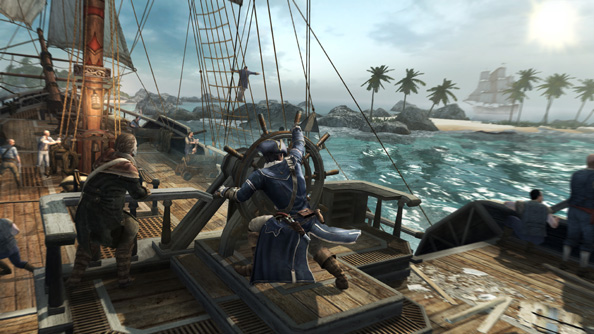
Your cannon, on the other hand, are locked in position, capable of firing only to the sides but packing significantly bigger metal balls than your swivel gun. The mission I played had our crew attempting to reclaim Martha’s Vineyard (one of the five place names in the USA with a possessive apostrophe, Wikipedia informs) by pummeling its defences with our cannon, strafing up and down along the coast until all three towers fell. Meanwhile we dodged incoming fire by half-ducking behind some barrels as the shots landed around the ship, presumably an authentic military tactic of the day.
Ships also link the mainland to a series of side-missions set around discovering Captain Kidd’s lost treasure. These are unlocked by bringing collectible trinkets dotted about the wilderness to a man of questionable accent, Peg Leg, who’ll then direct you to subsequent scraps of the infamous pirate’s map. These map hunts form Assassin’s Creed 3’s take on Brotherhood’s Lairs of Romulus, and are similarly stand-alone, platformer-esque dungeons. Fort Wolcott, where the lore insists one of Kidd’s crew had once been imprisoned, stands in Assassin’s Creed 3 as a British stronghold occupied by yammering, angry redcoats.
Stealth is the idea here, more so presumably than at most points in the game, with Connor hiding around darkened interiorcorners, tomahawking unsuspecting guards, leaping from second floor balconies and failing missions should he blunder into sight for too long. At one particularly tensepoint you pounce from chandelier to chandelier above a dining table of squabbling (and apparentlyslightly deaf) men, finally reaching the fort’s prison cells to retrieve the map fragment before, as per your orders, your waiting ship, still moored in the bay, launches a sustained and explosive barrage against the fort, like so many commas raining downon an overlong sentence.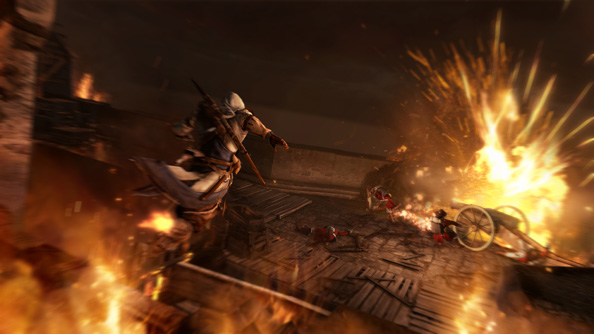
Here, the protagonist’s new ability to assassinate while running comes to the fore, as soldiersattempt unsuccessfullyto block your path while the buildings and guntowers begin to buckle and collapse around your tinycrushable headin great smouldering fireballs. It’s a cinematic, free-running showcase – routes are destroyed rightbefore you as others simultaneously andconveniently open up, all while you sprint against a timer to reach the fort’s edge and watery safety. These pre-designed paths carved through interaction-averse explosions are several steps away from the beauty of Assassin’s Creed 3 dynamic open-world, but you’ll barely care when you’re neck deep in them. Brotherhood’s later ‘Lair’ missions pushed the game’s platforming mechanic to its limit too, you can hope that Assassin’s Creed 3 will be just as testing in places.
That said, Ubisoft have tweaked controls to prevent you from automatically leaping to your splat-death when navigating scenery. You can still do it, by manually tapping the jump button, but the change feels necessary given the new setting – Connor can prance along lofty branches like a tree-gazelle (or a squirrel, I suppose), now just as capable of silkily animated runs through hisorganic surroundings as well as the bricks as masonry of Boston and New York.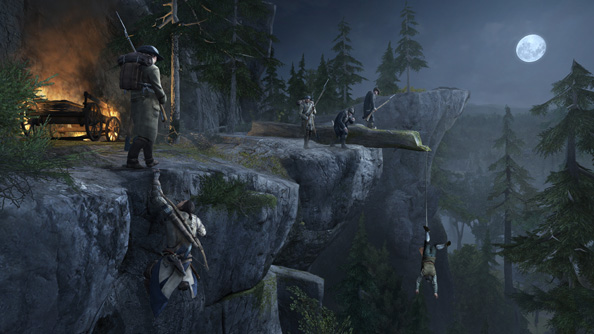
Actually getting up into the sparse canopy can be awkward however, as Connor can’t climb any tree he likes the look of. I’d been taskedwith thumping some hunters who’d taken potshots at a nice hunter lady Connor had decided to become friends with. Aftereach time I’d assassinated a hunter from the treetopsI found myselfrepeatedly backtracking to a convenient ladder I’d spotted. Ladders feel a bit like cheating. Anybody, at any stage of their assassin training,can climb a tree using a ladder. That said, thereare sometrees with low-hanging branches and some well-positioned rocky outcrops that allow more satisfyingly ninja-like access to these higher areas.
The hunter I was helping was Myriam, her request a part of the game’s optional Homestead missions. These missions help to rebuild Connor’s picket-fenced townhouse and aid the local community, and with Myriam’s assistance I’d have access to a regular supply of pelts and hunter gear, which are used in Assassin’s Creed 3’s crafting system. The mission itself was the game’s way of training you to use Connor’s new hook-dart – a sort of grim flesh-piercing spike on the end of a long rope – by ensnaring each of the hunters from the treetops in turn. Tethering a hunter while perched like this allows you to then drop from the branch and, using Connor as a counterweight, hoist the enemy up off the ground. The weapon is brilliantly unnecessary, absolutely unlikely, humiliating and modestly gruesome, a welcome addition to the Assassin’s Creed armoury.
I felt I’d done Connor a favour by briefly dragging him away from the concerns of his Mohawk tribe, the ongoing war between Assassins and Templars and the trans-Atlantic bickering to offer him the simple pleasures ofpiloting huge colonialwarships, fostering a wholesome and welcominghomesteadandstroking household pets. That I could spend a few hours dithering in the world Ubisoft have created -discovering maps to lost treasure, fighting off packs ofwolves to find trinkets and rescuing hunters from madmen -all while only progressing the game’s main plot by mere inches, speaks to the breadth of the open-world being offered.
Assassin’s Creed 3 is built for dawdling. If you start playing it on its release on November 23, there’s every chance you’ll delay so much in tackling the plot that the Americans will never claim their continent, the might of the Empire would spread ever westward,thus rewriting history and causing the game to have never been invented.
If that’s confusing, here are the basics again:
